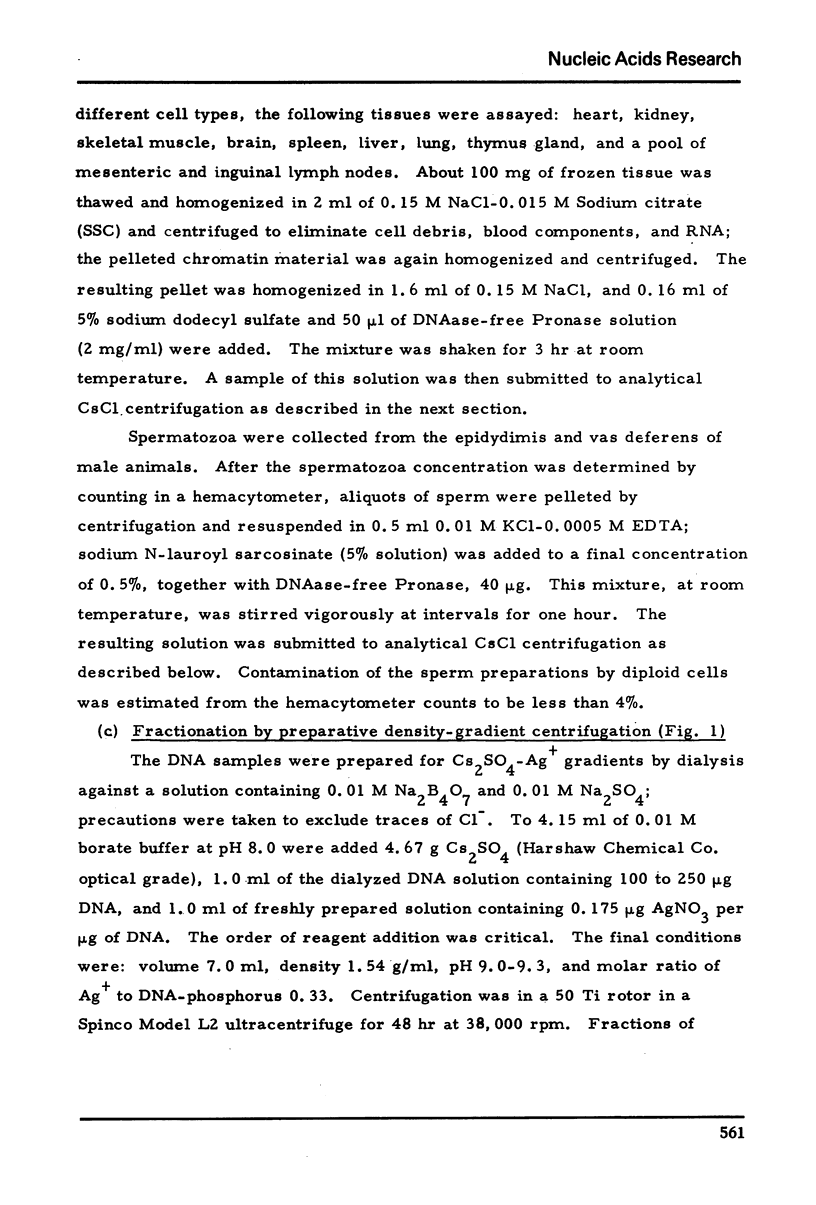Abstract
Nuclear DNA from liver cells of the kangaroo rat species Dipodomysordii was fractionated and characterized with the aid of buoyant density gradients in neutral and alkaline CsCl and in Ag+-Cs2SO4. More than one-half of the DNA was present in three density satellites, a greater proportion than in any other species yet reported; the purified satellite DNAs were denser than principal DNA. All satellite fractions revealed sharp isopycnic bands and narrow denaturation profiles. Two had identical buoyant densities but differed substantially in Tm, base composition, and reassociation kinetics. In alkaline CsCl all three satellites, as well as a shoulder of intermediate repetitive DNA on the heavy side of the principal band, revealed unique strand densities. The most highly repetitive satellite was unusually rich in (G + C) and contained 6.7% of 5-methylcytosine. A survey of internal organs and spermatozoa of an adult male revealed no significant differences in distribution of the satellites among tissues.
Full text
PDF
















Selected References
These references are in PubMed. This may not be the complete list of references from this article.
- Bostock C. J., Prescott D. M., Hatch F. T. Timing of replication of the satellite and main band DNAs in cells of the kangaroo rat (Dipodomys ordii). Exp Cell Res. 1972 Oct;74(2):487–495. doi: 10.1016/0014-4827(72)90405-3. [DOI] [PubMed] [Google Scholar]
- Flamm W. G. Highly repetitive sequences of DNA in chromosomes. Int Rev Cytol. 1972;32:1–51. doi: 10.1016/s0074-7696(08)60337-x. [DOI] [PubMed] [Google Scholar]
- Flamm W. G., Walker P. M., McCallum M. Renaturation and isolation of single strands from the nuclear DNA of the guinea pig. J Mol Biol. 1969 Jun 28;42(3):441–455. doi: 10.1016/0022-2836(69)90235-6. [DOI] [PubMed] [Google Scholar]
- Fry K., Poon R., Whitcome P., Idriss J., Salser W., Mazrimas J., Hatch F. Nucleotide sequence of HS-beta satellite DNA from kangaroo rat Dipodomys ordii. Proc Natl Acad Sci U S A. 1973 Sep;70(9):2642–2646. doi: 10.1073/pnas.70.9.2642. [DOI] [PMC free article] [PubMed] [Google Scholar]
- Hatch F. T., Mazrimas J. A., Koranda J. J., Martin J. R. Ecology and radiation exposure of kangaroo rats living in a tritiated environment. Radiat Res. 1970 Oct;44(1):97–107. [PubMed] [Google Scholar]
- Hatch F. T., Mazrimas J. A. Satellite DNA's in the kangaroo rat. Biochim Biophys Acta. 1970 Nov 12;224(1):291–294. doi: 10.1016/0005-2787(70)90651-9. [DOI] [PubMed] [Google Scholar]
- Hsu T. C., Arrighi F. E., Saunders G. F. Compositional heterogeneity of human heterochromatin. Proc Natl Acad Sci U S A. 1972 Jun;69(6):1464–1466. doi: 10.1073/pnas.69.6.1464. [DOI] [PMC free article] [PubMed] [Google Scholar]
- MARMUR J., DOTY P. Determination of the base composition of deoxyribonucleic acid from its thermal denaturation temperature. J Mol Biol. 1962 Jul;5:109–118. doi: 10.1016/s0022-2836(62)80066-7. [DOI] [PubMed] [Google Scholar]
- Mazrimas J. A., Hatch F. T. A possible relationship between satellite DNA and the evolution of kangaroo rat species (genus Dipodomys). Nat New Biol. 1972 Nov 22;240(99):102–105. doi: 10.1038/newbio240102a0. [DOI] [PubMed] [Google Scholar]
- Mazrimas J. A., Hatch F. T. Intranuclear distribution of satellite DNA from kangaroo rat. Exp Cell Res. 1970 Dec;63(2):462–466. doi: 10.1016/0014-4827(70)90240-5. [DOI] [PubMed] [Google Scholar]
- Prescott D. M., Bostock C. J., Hatch F. T., Mazrimas J. A. Location of satellite DNAs in the chromosomes of the kangaroo rat (Dipodomys ordii). Chromosoma. 1973;42(2):205–213. doi: 10.1007/BF00320941. [DOI] [PubMed] [Google Scholar]
- SCHILDKRAUT C. L., MARMUR J., DOTY P. Determination of the base composition of deoxyribonucleic acid from its buoyant density in CsCl. J Mol Biol. 1962 Jun;4:430–443. doi: 10.1016/s0022-2836(62)80100-4. [DOI] [PubMed] [Google Scholar]
- Salomon R., Kaye A. M., Herzberg M. Mouse nuclear satellite DNA: 5-methylcytosine content, pyrimidine isoplith distribution and electron microscopic appearance. J Mol Biol. 1969 Aug 14;43(3):581–592. doi: 10.1016/0022-2836(69)90360-x. [DOI] [PubMed] [Google Scholar]
- Skinner D. M., Beattie W. G., Kerr M. S., Graham D. E. Satellite DNAs in crustacea: 2 different components with the same density in neutral CsCl gradients. Nature. 1970 Aug 22;227(5260):837–839. doi: 10.1038/227837a0. [DOI] [PubMed] [Google Scholar]
- Southern E. M. Base sequence and evolution of guinea-pig alpha-satellite DNA. Nature. 1970 Aug 22;227(5260):794–798. doi: 10.1038/227794a0. [DOI] [PubMed] [Google Scholar]
- Symons R. H. Practical methods for the routine chemical synthesis of 32P-labelled nucleoside di- and triphosphates. Biochim Biophys Acta. 1970;209(2):296–305. doi: 10.1016/0005-2787(70)90728-8. [DOI] [PubMed] [Google Scholar]
- Thrower K. J., Peacocke A. R. Kinetic and spectrophotometric studies on the renaturation of deoxyribonucleic acid. Biochem J. 1968 Oct;109(4):543–557. doi: 10.1042/bj1090543. [DOI] [PMC free article] [PubMed] [Google Scholar]
- Vanyushin B. F., Tkacheva S. G., Belozersky A. N. Rare bases in animal DNA. Nature. 1970 Mar 7;225(5236):948–949. doi: 10.1038/225948a0. [DOI] [PubMed] [Google Scholar]
- Walker P. M. "Repetitive" DNA in higher organisms. Prog Biophys Mol Biol. 1971;23:145–190. doi: 10.1016/0079-6107(71)90019-8. [DOI] [PubMed] [Google Scholar]
- Wetmur J. G., Davidson N. Kinetics of renaturation of DNA. J Mol Biol. 1968 Feb 14;31(3):349–370. doi: 10.1016/0022-2836(68)90414-2. [DOI] [PubMed] [Google Scholar]


